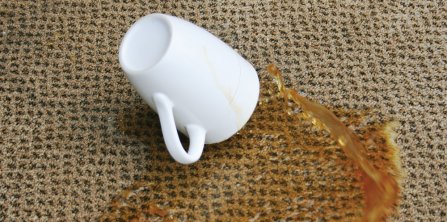Clean Up Your Act
 Click on image to enlarge
Click on image to enlarge
Perceived as being difficult to clean, carpet has often been avoided on the basis that it can quickly become dirty and hence off-putting. However, even if building managers don’t have much budget, there are a few simple and cost-effective methods they can adopt to help enhance the aesthetic and functional benefits of carpet and lengthen the carpet’s lifecycle.
Soiling occurs in different ways, it is either ‘tracked in’, deposited from the air, or spilled. There are various cleaning methods that you can apply depending on the type of soiling.
Firstly, you can use a lightweight carpet sweeper to remove loose surface soil and small pieces of debris in localised areas. Next, you can use a good quality upright vacuum cleaner fitted with a reel type brush to remove dirt from the pile.
It is important to vacuum on a regular basis as tracked in dirt such as grit will cause abrasion and will remove the lustre from the fibre making the carpet duller in appearance. If a spillage is wet, use a spatula to remove it before applying water or a recommended cleaning agent to the carpet.
Carpet showing moderate soiling can be cleaned with a dry cleaning compound, used in accordance with the carpet manufacturer’s recommendations. Periodical specialist cleaning may also be required to remove contaminants such as chewing gum.
For a high quality carpet, a program of consistent maintenance that extends the life as long as possible is usually more economical. Luxury or premium carpets should be deep cleaned professionally on a regular basis using a ‘hot water extraction system’ to avoid heavy build up of dirt and to remove staining and bacteria.
Carpets such as Gradus’ Genus and Volnay ranges are manufactured using Marquesa solution dyed yarn, which has been developed to make the cleaning of spillages and soiling easier to deal with, whilst ensuring the carpet retains a fresh look. The Marquesa yarn is non-absorbent and therefore, keeps dirt and liquids on the surface of the yarn, preventing it from entering the fibre. This reduces cleaning times and makes the cleaning process less strenuous.
The cleanability and bleach resistance of these carpet ranges means that spillages and stains can be removed with bleach and other intensive cleaning agents, without damaging the carpet’s appearance or fibres. This helps to reduce lifecycle costs as a cleanable, durable carpet does not need to be replaced so frequently as a result of soiling, making it a cost-effective choice in the longer-term.
To summarise, a consistent, well-planned maintenance program will help to maintain a carpet’s functionality and aesthetics, it will help to improve safety and indoor air quality, and will help to extend the life of a carpet. These are strong messages for specifiers and building owners, as they all add up to longer carpet lifecycles and reduced costs over time.
Please click here to view the Genus cleaning demonstration video.



